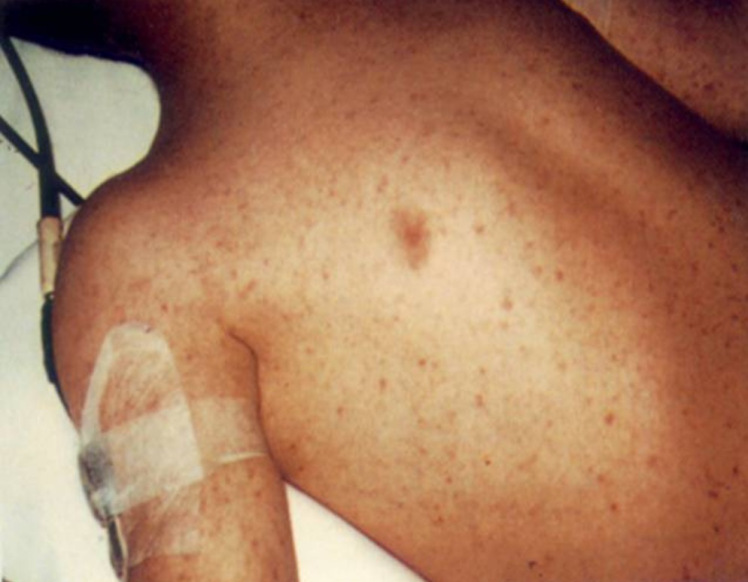Fat embolism syndrome physical examination
|
Fat embolism syndrome Microchapters |
|
Diagnosis |
|---|
|
Treatment |
|
Case Studies |
|
Fat embolism syndrome physical examination On the Web |
|
American Roentgen Ray Society Images of Fat embolism syndrome physical examination |
|
Risk calculators and risk factors for Fat embolism syndrome physical examination |
Editor-In-Chief: C. Michael Gibson, M.S., M.D. [1] Associate Editor(s)-in-Chief: Feham Tariq, MD [2]
Overview
Fat embolism syndrome(FES) is characterized by multisystem dysfunction most commonly presents in 12 to 72 hours after the initial insult. It is a clinical diagnosis and requires high degree of suspicion. The classic triad of clinical manifestations are petechiae, hypoxemia and neurological abnormalities. Pulmonary manifestations are the most common initial signs of FES and include dyspnea, tachypnea, hypoxemia, and respiratory failure of which the hypoxemia is the earliest feature that. Other findings on physical examination are retinal exudates, scotomatas and intravascular fat globules.
Physical Examination
The physical examination findings more commonly appear after 12-72 hours of the initial insult. The classic triad of clinical manifestations seen on physical examination in fat embolism syndrome include the following:[1][2][3][4]
General physical examination:
The following findings are seen on general physical examination:
- Petechiae: Reddish brown non-palpable rash
- Appear within 24-36 hours and disappear within a week in 20-50% of patients.
- Classically seen in the non-dependent regions such as:
- Axillae
- Conjunctiva
- Anterior thorax
- Head and neck
- Tachypnea
- Tachycardia
- Lethargy
- Cyanosis
Neurological exam findings:
The following physical exam findings are seen on neurological examination. They are present mainly due to cerebral edema:[7]
- Focal neurological deficit
- Confusion
- Rigidity
- Convulsions
- Anisocoria
- Conjugate eye deviation
- Coma
Ophthalmological examination:
Fundoscopic examination shows the following changes in the retina:[8][9][10]
- Exudates
- Intravascular fat globules
- Edema
- Hemorrhage
- Retinal scotomata (Purtscher's retinopathy)
Gallery

References
- ↑ Jacobson DM, Terrence CF, Reinmuth OM (1986). "The neurologic manifestations of fat embolism". Neurology. 36 (6): 847–51. PMID 3703294.
- ↑ Scopa M, Magatti M, Rossitto P (1994). "Neurologic symptoms in fat embolism syndrome: case report". J Trauma. 36 (6): 906–8. PMID 8015021.
- ↑ Fu QZ (1988). "[Early diagnosis and treatment of fat embolism syndrome after multiple fractures]". Zhonghua Wai Ke Za Zhi. 26 (12): 739–41, 782. PMID 3248470.
- ↑ Georgopoulos D, Bouros D (2003). "Fat embolism syndrome: clinical examination is still the preferable diagnostic method". Chest. 123 (4): 982–3. PMID 12684280.
- ↑ Bardana D, Rudan J, Cervenko F, Smith R (1998). "Fat embolism syndrome in a patient demonstrating only neurologic symptoms". Can J Surg. 41 (5): 398–402. PMC 3949781. PMID 9793509.
- ↑ Akhtar S (2009). "Fat embolism". Anesthesiol Clin. 27 (3): 533–50, table of contents. doi:10.1016/j.anclin.2009.07.018. PMID 19825491.
- ↑ Byrick RJ (2001). "[Fat embolism and postoperative coagulopathy]". Can J Anaesth. 48 (7): 618–21. doi:10.1007/BF03016192. PMID 11495865.
- ↑ Murray DG, Racz GB (1974). "Fat-embolism syndrome (respiratory insufficiency syndrome). A rationale for treatment". J Bone Joint Surg Am. 56 (7): 1338–49. PMID 4447657.
- ↑ Herndon JH, Riseborough EJ, Fischer JE (1971). "Fat embolism: a review of current concepts". J Trauma. 11 (8): 673–80. PMID 4935648.
- ↑ Arbus L, Fabre J, Bechac G, Lazorthes Y (1973). "Clinical, ophthalmoscopic and biological findings in systemic fat embolism. Pathogenetic theory and treatment in 30 cases". Acta Neurochir (Wien). 29 (1): 89–104. PMID 4780652.